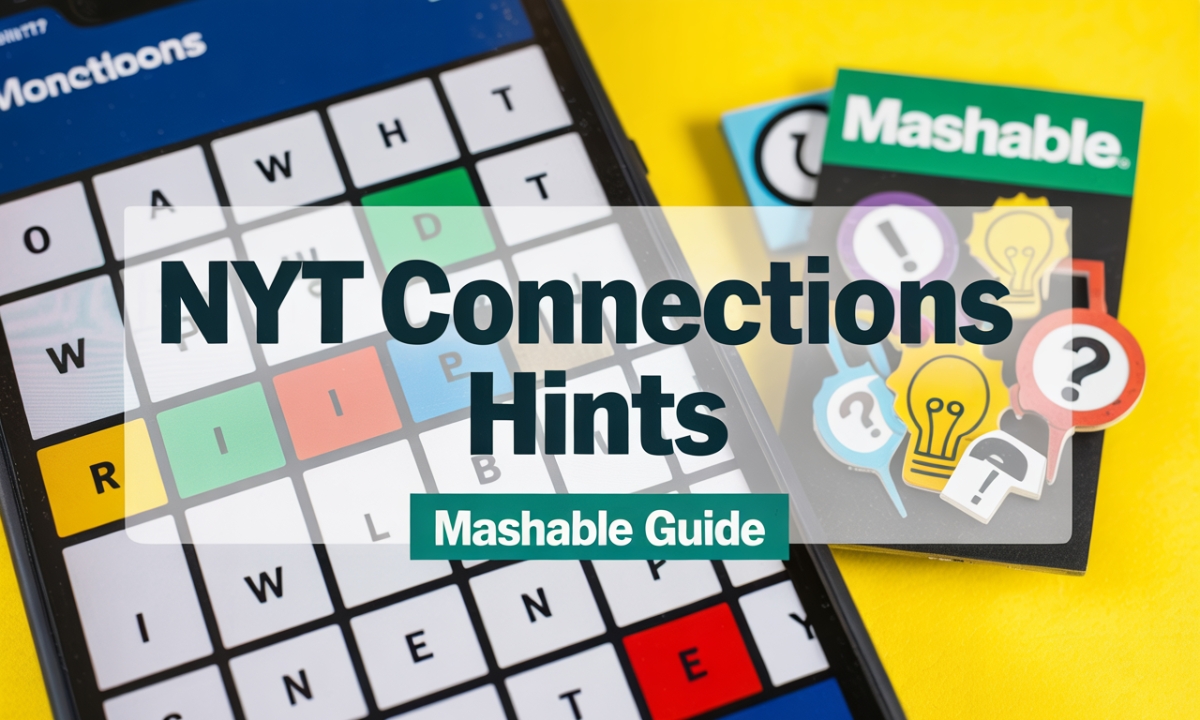Staring at 16 words scattered across your screen, convinced they’re personally mocking your intelligence? You’re not alone. The New York Times Connections puzzle has become America’s latest obsession, challenging millions of players daily with its deceptively simple premise. But here’s the secret weapon savvy puzzlers have discovered: Mashable’s NYT Connections hints transform frustrating dead ends into satisfying “aha!” moments.
This comprehensive guide reveals how to leverage Mashable’s expert hints effectively, turning you from a struggling novice into a confident puzzle solver. You’ll discover proven strategies, understand different connection types, and learn why Mashable stands out among hint providers. Ready to crack today’s puzzle with confidence?
What is the NYT Connections Puzzle?
The NYT Connections puzzle burst onto the scene in June 2023, created by associate puzzle editor Wyna Liu. This daily brain teaser presents 16 seemingly random words that conceal four groups of four connected items. Think of it as a verbal jigsaw puzzle where you’re hunting for hidden relationships.
Unlike traditional crosswords or word games, Connections demands pattern recognition and lateral thinking. You might encounter words like “BASS,” “TREBLE,” “TWITTER,” and “CHIRP” – can you spot the connection? (Hint: they’re all sounds birds make, but “BASS” and “TREBLE” might mislead you toward music terminology.)
The Color-Coded Difficulty System
Each puzzle follows a structured difficulty progression:
| Color | Difficulty | Typical Characteristics |
| Yellow | Easiest | Straightforward, literal connections |
| Green | Medium | Requires some lateral thinking |
| Blue | Harder | Abstract concepts, wordplay |
| Red | Hardest | Obscure references, tricky associations |
The puzzle’s genius lies in its trap answers – deliberately misleading connections designed to waste your precious four allowed mistakes. This is where Mashable’s NYT Connections hints become invaluable, helping you navigate these intentional pitfalls.
Cultural Impact and Player Engagement
Since launch, NYT Connections has attracted over 2 million daily players, rivaling Wordle’s popularity. The puzzle’s social sharing feature creates water cooler conversations nationwide, with players comparing strategies and celebrating victories. Unlike speed-based games, Connections rewards patience and methodical thinking – qualities that align perfectly with Mashable’s hint philosophy.
How Does the NYT Puzzle Work?
Understanding the NYT Connections puzzle mechanics is crucial before diving into hint strategies. The game presents a 4×4 grid of words, and your mission is identifying four groups of four connected items. You select four words you believe share a common theme, then submit your guess.
The Four-Strike System
Here’s where pressure mounts: you only get four incorrect guesses before the puzzle locks you out. This limitation makes each selection crucial and transforms casual word play into strategic decision-making. One wrong move in the red category can end your game.
When you successfully identify a group, those four words disappear from the grid, revealing their connection and difficulty color. This progressive revelation helps with remaining categories, but also increases pressure as options narrow.
Strategic Shuffle Feature
The shuffle button becomes your best friend when you feel stuck. Rearranging words often reveals new patterns your brain initially missed. Many successful players shuffle repeatedly, letting their subconscious process fresh arrangements.
Scoring and Social Elements
Unlike competitive puzzles, Connections doesn’t track completion time. Instead, it measures accuracy and celebrates perfect games (solving all four groups without mistakes). The social sharing feature displays your color pattern without spoiling answers, enabling discussion without ruining others’ experiences.
This format perfectly complements Mashable’s hint approach, which provides guidance without destroying the discovery process. You still earn that satisfying “aha!” moment while receiving enough support to avoid frustration.
How Mashable Provides Valuable NYT Connections Hints
Mashable’s NYT Connections hints have earned recognition for their thoughtful balance between helpful guidance and puzzle integrity. Their editorial team understands that players want support, not outright answers, creating a tiered hint system that respects the solving process.
The Progressive Hint Methodology
Mashable structures their hints using a graduated revelation system:
- Gentle Nudges: Thematic clues that point toward general categories
- Specific Guidance: More direct hints about particular groups
- Clarifying Details: Explanations that resolve ambiguity
- Complete Answers: Full solutions for desperate moments
This approach lets you choose your level of assistance. Stuck on just one group? Grab a gentle nudge. Completely baffled? Work through their progressive hints until clarity emerges.
Timing and Accessibility
Mashable publishes their NYT Connections hints within hours of each puzzle’s release, ensuring availability when players need support most. Their articles appear consistently around 6 AM EST, perfect for morning coffee puzzle sessions.
Their web format remains easily accessible across devices, with clear navigation and spoiler warnings. You won’t accidentally glimpse tomorrow’s answers while seeking today’s hints.
Editorial Quality and Expertise
Mashable’s puzzle coverage team includes experienced word game enthusiasts who understand player psychology. They recognize when connections feel unfair or when multiple interpretations exist, addressing these concerns in their hint explanations.
Their writing style remains conversational and encouraging, treating readers as puzzle partners rather than struggling students. This tone reduces frustration while maintaining engagement with the solving process.
Types of Connections You’ll Encounter
Mastering NYT Connections puzzle types dramatically improves your success rate. Each category style requires different thinking approaches, and understanding these patterns helps you interpret Mashable’s hints more effectively.
Literal Connections (Usually Yellow)
These straightforward groups connect obvious shared characteristics:
- Animals: TIGER, BEAR, LION, WOLF
- Colors: BLUE, RED, GREEN, YELLOW
- Professions: DOCTOR, TEACHER, LAWYER, ENGINEER
Mashable’s approach: They often provide simple categorical hints like “Think about the animal kingdom” or “Consider professional roles.”
Wordplay Categories (Green/Blue)
These connections require linguistic creativity:
- Homophones: BREAK/BRAKE, FLOUR/FLOWER, DEAR/DEER, PEAR/PAIR
- Shared Prefixes: SUBWAY, SUBPAR, SUBTRACT, SUBMARINE
- Word Completion: Words that can follow “FIRE” (TRUCK, PLACE, WORKS, DRILL)
Mashable’s strategy: They provide structural hints like “Think about words that sound alike” or “Consider what comes after…”
Pop Culture Groups (Blue/Red)
These categories test cultural knowledge:
- Movie Titles: JAWS, CARS, UP, HER
- Song Names: HELLO, SORRY, ROLLING, YESTERDAY
- TV Shows: FRIENDS, LOST, HOUSE, BONES
Mashable’s technique: They offer contextual clues like “Think entertainment” or “Consider the 1990s television landscape.”
Abstract Concepts (Often Red)
The trickiest connections involve conceptual thinking:
- Emotions: JOY, ANGER, FEAR, DISGUST
- Actions: SKIP, JUMP, HOP, LEAP
- Philosophical Concepts: TRUTH, BEAUTY, JUSTICE, FREEDOM
Mashable’s method: They provide thoughtful guidance like “Consider human experiences” or “Think about fundamental concepts.”
Puzzle-Solving Tips Using Mashable Hints
Maximizing Mashable’s NYT Connections hints requires strategic reading and application. Here’s how to extract maximum value while preserving the puzzle’s challenge.
Pre-Hint Assessment Strategy
Before consulting any hints, perform this systematic evaluation:
- Scan for obvious groups – Look for clear categorical connections
- Identify potential traps – Note words that could belong to multiple groups
- Consider difficulty progression – Start with yellow-level thinking
- Use elimination logic – Rule out impossible combinations
This initial assessment makes Mashable’s hints more effective by focusing your attention on specific challenges rather than general confusion.
Reading Hints Strategically
Mashable structures their hints to prevent accidental spoilers while providing escalating assistance:
- Read thematic hints first – These provide direction without revealing answers
- Focus on one group at a time – Don’t overwhelm yourself with multiple hints
- Use process of elimination – Apply hints to narrow possibilities
- Return to the puzzle between hints – Let each clue marinate before seeking more
Advanced Hint Application
Experienced players develop sophisticated approaches to Mashable’s guidance:
Pattern Recognition: Look for recurring themes in Mashable’s language. When they mention “think outside the box,” expect wordplay or abstract connections.
Reverse Engineering: Use remaining words to deduce categories. If three groups are solved, the final four must connect somehow.
Contextual Clues: Mashable often provides cultural or historical context that clarifies obscure references without giving direct answers.
Common Mistake Avoidance
Mashable’s hints help you avoid these frequent errors:
- Overthinking yellow categories – Simple is often correct
- Assuming logical connections – Sometimes groupings feel arbitrary
- Ignoring wordplay possibilities – Consider multiple meanings
- Rushing through hints – Take time to process each suggestion
Alternative Resources & Community Support
While Mashable’s NYT Connections hints excel in quality and accessibility, exploring additional resources enhances your puzzle-solving toolkit and builds community connections.
Competing Publication Approaches
USA Today: Provides more direct answers with less progressive guidance Washington Post: Focuses on cultural context and historical references
The Guardian: Offers British perspective on American cultural references Entertainment Weekly: Specializes in pop culture category explanations
Digital Communities and Forums
Reddit’s r/NYTConnections has become the unofficial headquarters for puzzle discussion. Daily threads provide:
- Real-time hint sharing
- Alternative perspective discussions
- Pattern recognition insights
- Community celebration of successes
Discord servers offer instant communication with fellow solvers, perfect for those “I’m stuck!” moments when Mashable’s hints need supplementation.
Video and Audio Resources
YouTube channels like “Puzzle Master” and “Word Game Wednesday” provide visual solving demonstrations, helpful for understanding connection visualization techniques.
Podcast coverage appears on shows like “The Puzzle Show” and “Game Theory,” offering weekly analysis of notable puzzles and solving strategies.
Social Media Integration
Twitter hashtags (#NYTConnections, #ConnectionsPuzzle) create real-time discussion streams where players share victories, frustrations, and alternative solutions.
Instagram stories from puzzle influencers provide daily hints and solving tips, complementing Mashable’s more comprehensive coverage.
Why Mashable Stands Out
Among numerous NYT Connections hint providers, Mashable has earned distinction through consistent quality, thoughtful approach, and reader-focused content strategy.
Editorial Excellence and Consistency
Mashable’s puzzle team demonstrates remarkable consistency in their hint quality. Unlike competitors who occasionally provide confusing or misleading guidance, Mashable maintains editorial standards that respect both puzzle integrity and reader intelligence.
Their fact-checking process ensures accuracy in cultural references and wordplay explanations. When puzzles reference specific movies, songs, or historical events, Mashable provides reliable context without overwhelming detail.
Balanced Difficulty Approach
Mashable’s graduated hint system acknowledges that different players need different levels of assistance. Their articles structure information logically:
- Spoiler-free thematic hints appear first
- Progressive revelations follow for increased guidance
- Complete explanations satisfy readers seeking full understanding
- Cultural context enriches the learning experience
Reader Engagement and Feedback
Mashable actively responds to reader comments and suggestions, creating a dialogue rather than one-way content delivery. Their comment sections become mini-communities where players discuss strategies and share alternative solutions.
The publication’s social media presence extends puzzle coverage beyond articles, providing daily engagement and community building around NYT Connections challenges.
Integration with Broader Entertainment Coverage
Mashable’s entertainment expertise uniquely positions them for pop culture categories. Their staff’s deep knowledge of movies, music, television, and internet culture provides contextual richness that pure puzzle sites cannot match.
When puzzles reference specific franchises, historical events, or cultural phenomena, Mashable’s hints include background information that enhances understanding beyond simple category identification.
Technical Accessibility and User Experience
Mashable’s website design prioritizes user experience with:
- Mobile-optimized layouts for on-the-go solving
- Clear navigation between different hint levels
- Fast loading times for impatient puzzle solvers
- Accessible formatting for various reading preferences
Conclusion
Mashable’s NYT Connections hints represent the gold standard for puzzle assistance, striking the perfect balance between helpful guidance and preservation of the solving experience. Their progressive hint system, editorial excellence, and community engagement create a resource that enhances rather than replaces the puzzle-solving journey.
The key to maximizing Mashable’s value lies in strategic usage – treating their hints as training wheels rather than permanent solutions. As your pattern recognition improves and cultural knowledge expands, you’ll rely less on external guidance while appreciating the learning foundation Mashable provides.
Remember that puzzle-solving skills develop through practice and patience. Each day’s NYT Connections challenge offers new learning opportunities, whether you solve independently or with Mashable’s expert guidance. The goal isn’t perfect performance but continuous improvement and enjoyment of the mental exercise.
Ready to tackle today’s puzzle? Head over to Mashable’s latest NYT Connections hints and transform your solving experience from frustrating struggle to satisfying discovery. Your future puzzle-solving self will thank you for building these foundational skills today.
Pro tip: Bookmark Mashable’s puzzle section for daily access, but challenge yourself to attempt each puzzle independently before seeking hints. This approach maximizes learning while maintaining the joy of discovery that makes NYT Connections America’s favorite daily brain teaser.

Aarav Arjun, the admin of Kahaniyan.info, has 5 years of experience in managing and growing blogging websites. He carefully handles all content, making sure every story is engaging and well-organized. His dedication helps the site deliver quality stories to readers every day.





